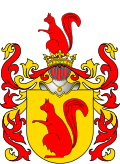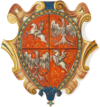Achinger coat of arms
| Achinger | |
|---|---|
 | |
| Alternative name(s) | Aichinger, Ajchinger, Ajchigier, Bażyński, Kieystucz, Wiewiórka |
| Earliest mention | 15th century[1] |
| Families | 16 names Achinger, Adamski, Affanasowicz or Affanowicz, Aychingerski, Barwiński, Bażyński, Berwiński, Ichnatowicz, Ichnatowski, Ihnatowicz, Ihnatowski, Jagowd(owicz), Leszniewski, Pilchowski, Rycze(o)wski, Ryszewski. |
Achinger is a Polish coat of arms. It was used by several szlachta families in the times of the Kingdom of Poland and the Polish–Lithuanian Commonwealth.
Notable bearers
Among the notable bearers was szlachcic Augustyn Aichinger originally from Nuremberg, business partner of Konstanty Korniakt (1520–1603) who made his fortune in international trade and became financial advisor to moldavian hospodar Alexandru Lăpușneanu. Aichinger was active in Wallachia, where he served also as Korniakt's business contact. Their immensely profitable deals under the reign of King Sigismund II Augustus covered most of Central and Eastern Europe from Turkey to Germany, based on large-scale trade in Greek wines, cotton, honey, skins and furs.[2]
Other:
- Ajchingier family, Polish-German nobles
- Bażyński family (Baysen), Polish-German nobles
- Jan Bażyński, first Polish governor of Royal Prussia
- Gabriel Bażyński, Voivode of Chelmno
Gallery
-
Achinger variation
-
Achinger II
-
Achinger III
-
Łyśniewski, a variation of Achinger according to Pragart[3]
-
Łyśniewski I (a)
-
Łyśniewski II
-
Bartsch I, probably a variation of the Achinger
-
Bartsch II
See also
References
- ^ Alfred Znamierowski: Herbarz rodowy. Warszawa: Świat Książki, 2004, s. 87. ISBN 83-7391-166-9.
- ^ Krzysztof Bulzacki (2007–2012). "Rody Lwowskie - część I (Lwow noble families - part one)". Alembekowie, Boimowie, Korniaktowie, Kampianie, Barączowie, Baczewscy (in Polish). Stanisław Kosiedowski - Mój Lwów. Retrieved 10 July 2013.
- ^ Przemysław Pragert: Herbarz rodzin kaszubskich. T. 2. BiT, 2007, s. 124-126, 268. ISBN 978-83-924425-9-2.
Bibliography
- Kasper Niesiecki: Herbarz Polski (Polish Armorial), Lwów, 1738
- Tadeusz Gajl: Herbarz polski od średniowiecza do XX wieku : ponad 4500 herbów szlacheckich 37 tysięcy nazwisk 55 tysięcy rodów. L&L, 2007. ISBN 978-83-60597-10-1.
- Herbarz rodowy, Alfred Znamierowski, Warszawa 2004, ISBN 83-7391-166-9
- Józef Szymański: Herbarz rycerstwa polskiego z XVI wieku. Warszawa: DiG, 2001, s. 7. ISBN 83-7181-217-5.




![Łyśniewski, a variation of Achinger according to Pragart[3]](http://upload.wikimedia.org/wikipedia/commons/thumb/b/b6/POL_COA_%C5%81y%C5%9Bniewski.svg/120px-POL_COA_%C5%81y%C5%9Bniewski.svg.png)





